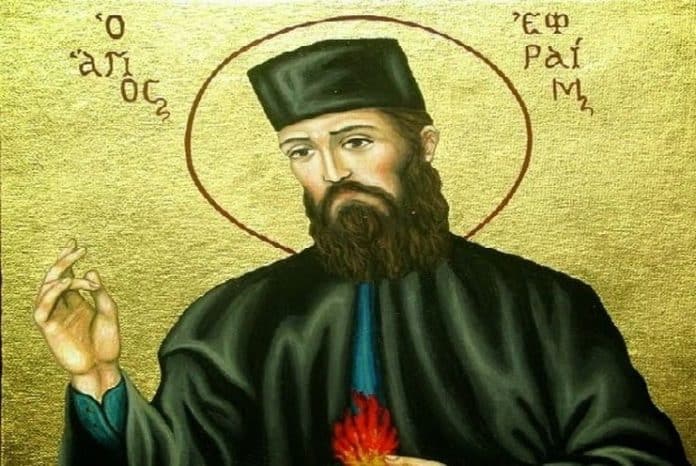Saint Ephraim (September 14, 1384 – May 5, 1426) is one of the newly appeared saints. Today we celebrate the finding of the holy relics of St.
Saint Ephraim, born Konstantinos Morphis, was born in Trikala on September 14, 1384 AD. in an idyllic location, near the Litheos river. He was orphaned by his father at an early age along with his other seven siblings, and their care, after God, was taken over by his pious mother. At the age of 14, in order to avoid conversion to Islam and the janissary bodies, he entered the then flourishing Stauropigian Holy Monastery of the Annunciation of the Most Holy Theotokos of the Mount of the Immaculate (Cathars) in Attica.
St. Ephraim followed Christ with divine zeal, and excelled with the brilliance of his life and the pains of his sport in the mountain of the Immaculate Attica (Nea Makris Region). He still deserved to receive the great Mystery of the Priesthood and the gift of serving the holy altar, like an angel of God, with the fear of God and much zeal.
In 1416 AD the Turks invaded and looted Attica and forced the Duke of Athens to submit to the Sultan. In 1424 AD the Turks violently invaded the Monastery of the Annunciation and slaughtered all the Fathers of the Monastery. The Saint was absent in his cave on the mountain for prayer and as soon as he returned he saw the corpses of the Fathers in fear. After burying them, he then mourned loudly.
The following year, on September 14, 1425 AD, the barbarians returned and found the Saint. He was arrested and his martyrdom began, which ended on May 5, 1426 AD. day Tuesday at 9 o'clock in the morning. They hung him upside down on a tree that is still alive, nailed him to the legs and head, and finally pierced his astonished and martyred body with a burning stick and thus handed over his holy soul to the crowned Christ.
After half a millennium the benevolent God prospered and revealed, after many appearances of St. Ephraim himself and many other miraculous events, all that we know today, which were confirmed by the finding of the martyrdom and graceful relics of the Saint on January 3, 1950. Χ.
Saint Ephraim is celebrated twice a year, on January 3, the finding of his relics, and on May 5, his martyrdom.
In Trikala, he is celebrated by the Holy Church of Agios Stefanos, opposite which, according to tradition, was his father's house.
In 2011 AD the Ecumenical Patriarchate of Constantinople with No. 217/2-3-2011 Patriarchal and Synodal Act included Saint Ephraim in the official orthodox calendar.
THE HISTORY OF THE MONASTERY OF AGIAS MAKRIS
From the massacres of the Turks to the discovery of the sacred tent of the Saint
The Monastery of Saint Ephraim in Nea Makri is one of the oldest monasteries. Many monks and priests stayed there and prayed to the Lord. During the years of Turkish rule, large and barbaric massacres took place, where the monastery was destroyed.
In 1945 AD the nun Makaria at that time went to the ruins of the ancient monastery of Evangelismos, once called Stavropigiakia, of Mount Amomon, in the northeastern foothills of Pentelikos. By divine impulse, he formed a cell there and began to clear the ruins of the old Temple in order to rebuild it. There she often meditated that monks had lived in those lands over the centuries and prayed that one of them would meet or appear to her. A voice, at first silent but with time growing louder in her soul, told her: "Dig and you will find what you desire", until the moment a spot was revealed to her in the courtyard of the monastery.
So on January 3, 1950 AD she commissioned a laborer to dig the specific spot that her own soul indicated to her. Although the laborer was negative and wanted to dig anywhere but at this spot, finally, after pleas and prayers, the laborer was convinced and began to dig. The site had a half-demolished fireplace, wall and things that indicated that there had once been a monk's cell there. The first find, a head. In fact, the place emanated a fragrance.
"I knelt with reverence and embraced the Saint's shrine and deeply felt the extent of his martyrdom. My soul was filled with joy, I acquired a great treasure, and taking the soil with care I saw the harmony of its setting, which, despite so many centuries in the earth, had not been altered", wrote Abbess Makaria, describing the shocking things that happened to her.
With care, Abbess Makaria took out all the cloth and placed it in a box that was above the grave. It was obvious that he was a clergyman as his cassock had remained intact.
In the evening, while reading vespers, the Abbess heard footsteps. The sound came from the tomb, echoing to the church door. That's where she first saw him. He was tall with small round eyes, with a long black beard that reached his neck, dressed in the solitary garb. In one hand he had a flame and with the other he was blessing. He asked to be taken out of this locker they had him in. The very next day the Abbess cleaned the bones and placed them in a safe in the Sanctuary of the Temple.
That same night, the Saint appeared in her sleep, thanked her and revealed his name: Ephraim. The relic of Saint Ephraim has been kept there ever since and every day hundreds of believers visit it asking the Saint for his blessing and help. The Saint, by the grace of God, has performed thousands of miracles. In the vicinity of the Monastery, and protected by a building built around it, there is the mulberry tree on which Saint Ephraim breathed his last.
